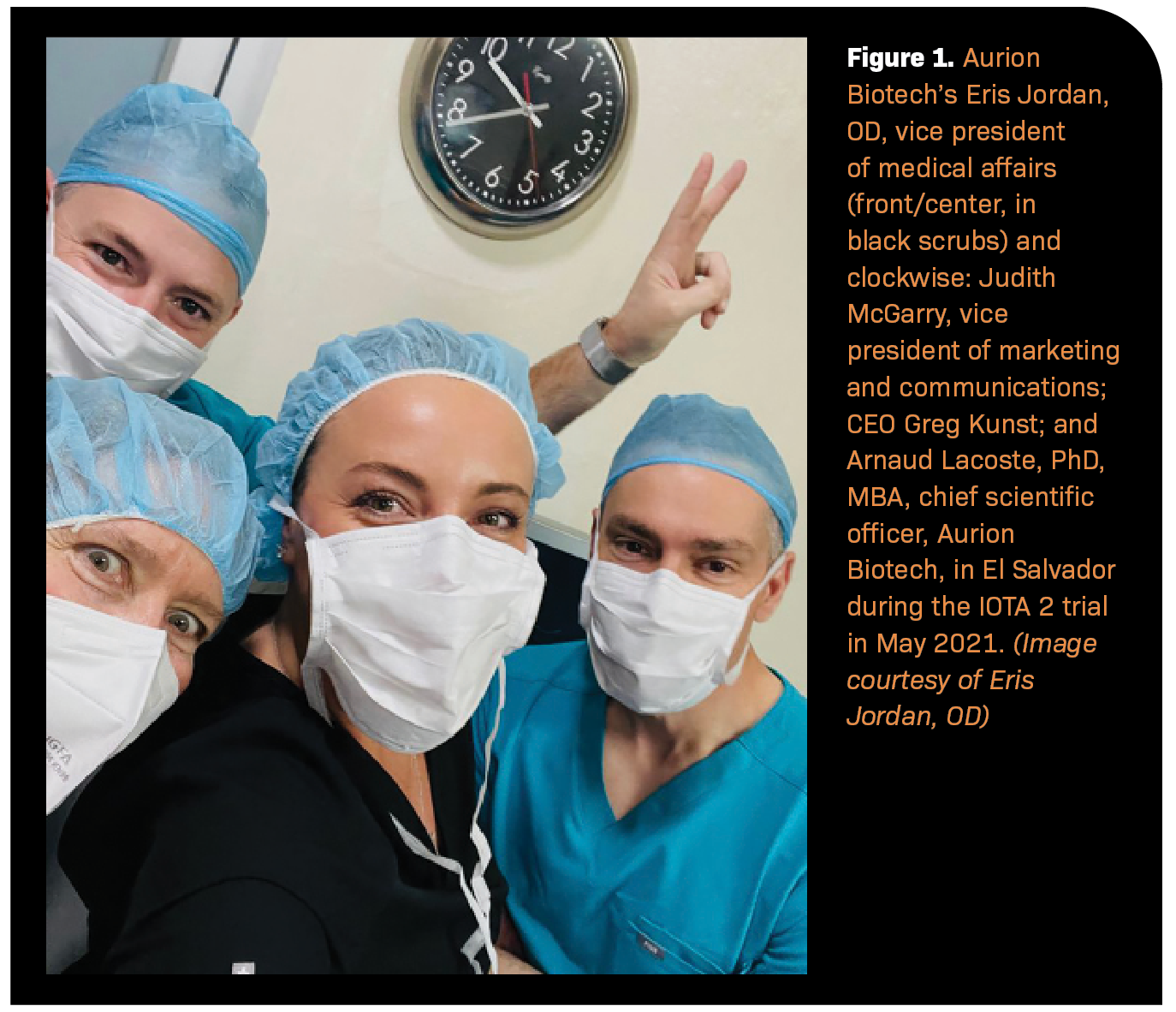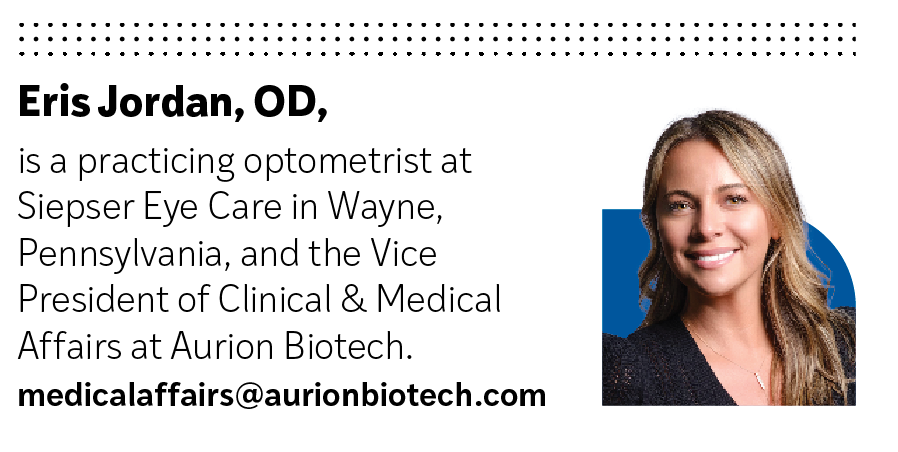Restoring sight against all odds
Clinical trial launch proves transformative for one optometrist’s career


In the practice of medicine, we’re trained to always put the patient first. But sometimes there is an evolution away from the ideals with which so many optometrists launch their careers. Over time, patient care can become routine, which can put us at odds with the true purpose of treating patients: caring for patients.
As an optometrist, I’ve had the privilege of working in both practice and industry. While each path has its own unique functions and challenges, both share a common denominator: the responsibility to provide the utmost level of care to patients.
I’ve always taken a keen interest in innovating the medical model of care and advancing clinical science, but the idea of “servitude” has felt true to me since I was very young. I come from a family of physicians; I used to watch my mother, a pediatrician, walk the villages of Albania to treat sick, underserved children. Ever since, I’ve felt a calling to serve that has permeated all aspects of my personal and professional life.
Cell therapy
In late 2019, I was given the opportunity to design an exploratory clinical trial for Aurion Biotech, a company whose mission is to restore vision to all who need it by developing a platform of innovative, accessible, and life-changing advanced therapies. Our first candidate, a patented cell therapy treatment for corneal endothelial disease, was developed by Professor Shigeru Kinoshita, MD, PhD, and his colleagues at the Kyoto Prefecture University of Medicine in Japan, subsequently acquired by Aurion. I jumped at the chance to serve as the architect of the first trial of this treatment outside Japan and to be able to bring cell therapy to patients in El Salvador who need it most.
Biotech innovation is both nuanced and complex, with a constant need to balance speed, efficiency, and results. Among several other drivers, creativity is paramount when navigating obstacles.
In order to develop a comprehensive clinical trial protocol, we had to document a procedure that, to date, had been performed by only a few Japanese ophthalmologists.
Because of the COVID-19 pandemic, we weren’t able to travel to Japan to observe the cell therapy procedure firsthand. Consequently, our only resources were videos of Kinoshita performing the procedure and Zoom calls with him to confirm the sequence of surgical steps.

Obstacles
To better understand patient outcomes, I began analyzing the medical records and slit-lamp images from the Japanese trials. While we intended to follow the Japanese protocol as closely as possible, several changes were needed for the trial in El Salvador.
Patients in Japan had been monitored postoperatively during the course of a 2-week hospital stay; however, we recognized the importance of shifting to an outpatient procedure to broaden the accessibility of the procedure.
Within a month, we had authored and submitted a revised protocol to the El Salvador Institutional Review Board and secured dates for study initiation in El Salvador. During that same time period, we worked with our colleagues at the study site, Clínica Quesada, to enroll 16 patients for treatment, and signed on 4 top US ophthalmic surgeons to serve as coinvestigators and perform the procedures.
Before departure, we were notified of the massive, Category-4 hurricane Iota bearing down on Central America. The projected path of the storm was to mirror that of a hurricane that had devastated the region 2 weeks prior. I called each of our surgeons to discuss the situation and consulted closely with our local colleagues. I knew they were passionate about the potential of this treatment, but I still fully expected them to be hesitant to conduct a trial in the midst of a Category-4 hurricane. To my surprise, every single investigator was “all in!”
We arrived in El Salvador (safely, it turns out, because the hurricane blew through the country with minimal damage), only to deal with myriad logistical and customs issues to get lab equipment and biologics delivered into the country in time for treatment. Despite daunting odds, our team worked around the clock and everything came together at the 11th hour (See Figure 1). Fittingly, the sun came out on the day we performed the procedures. We named the trial IOTA to commemorate the high stakes of the storms we weathered—literally and figuratively—to bring this sight-restoring treatment to patients.
IOTA trial
Patients in this trial suffer from bilateral corneal endothelial disease. Had they not been treated in the study, they would have likely faced the inevitable worsening of their condition, leading to corneal blindness. While keratoplasty exists as an alternative, it requires 1 donor cornea for each diseased eye and considerable surgical skill to perform the transplant. Given the limited worldwide donor cornea supply, as well as the finite number of surgeons able to perform complex keratoplasty, these patients would have had extremely limited access to proper care.
During part 1 of the IOTA trial, 16 patients were treated from a single donor. In the second part of our exploratory study, 34 patients were treated from another donor.
Follow-up of the IOTA trial patients is still ongoing; however, initial outcomes demonstrate great improvements as measured by reduced corneal edema, improved corneal clarity, and improved visual acuity. In many cases, functional blindness was reversed to functional vision.
Experience
There’s 1 word I use to sum up this effort: humbling. While the clinical results we are seeing from the IOTA trial are extremely promising, the experience has had a profound personal impact on me, as a person, clinician, and industry executive. We treated patients in dire need who otherwise would not have access to care. The El Salvador IOTA trial took me back to my roots.
It’s easy to become complacent in the US because we have such amazing care available to most patients, but there is a big world out there, full of unmet needs. It was important to remind myself why I do this work and it’s changed the way I practice. Having the opportunity to treat patients in El Salvador brought me back to the heart and soul of patient care.
Here in the US, I feel a deeper sense of fulfilment when I see patients. I’m more acutely aware of the responsibility I have to do right by them, to listen more attentively to their concerns, and thereby provide better patient care.
A new era of care
Innovation and new technology continue to transform ophthalmic care, which means that new roles for optometrists and ophthalmologists are constantly emerging. As new innovations come to market, collaboration between optometrists and ophthalmologists is going to become critically important.
Having spent the first half of my career primarily in private practice and the latter half in industry, I find the following few points to be equally applicable, regardless of career path:
» Treating patients is what drives the engine of innovation. Clinicians are empowered if they know what diseases to look for, to understand what treatments are possible, and when they are needed. Staying current with the innovations in our field is essential in providing the best possible care to patients.
» Curiosity is your best friend. The only way to know what is going to be meaningful or impactful to you in your career is to keep learning rather than focus on 1 path. In doing so, you’ll have the creativity and imagination to scope out new and shifting responsibilities in the field.
» You can do both! Optometrists can find meaningful, fulfilling work in industry while continuing in clinical practice. In fact, involvement in both can be deeply rewarding and make optometrists highly valued colleagues in both clinic and industry.
The IOTA trial has been a profound yet single experience; however, there are moments that occur on a daily basis to remind me how fortunate I am to do this work.
Maintaining my clinical practice while helping to advance transformational therapies at Aurion Biotech has given me the opportunity to see the full range of impact on the most important group: our patients.

Newsletter
Want more insights like this? Subscribe to Optometry Times and get clinical pearls and practice tips delivered straight to your inbox.